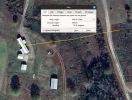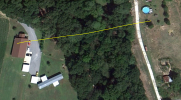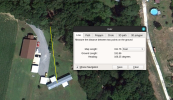Cullman continued...
Most of the ground level photos were exclusively shared with Tornado Talk by NWS surveyor Chris Darden. Considering this is a thread where we criticize tornado ratings and sometimes surveyors themselves I'm hesitant to share his photos without permission. Maybe
@NickKrasz_Wx can get it! This is why most of the images I share will be satellite photos with descriptions.
The most intense damage in Morgan county occurred at Beverly and Larry Pirkle's residence. They just finished this "dream home" after 3 years of construction and had only been living in it for 5 weeks. Two family members lived in double wide manufactured homes on the property as well. A change in treefall pattern just as the twister struck the residence showed that the primary subvortex was particularly tight and volatile here. No debris was left behind from any of the three structures aside from three distinct streaks 260-360 yards to the Northeast.
View attachment 45948
View attachment 45949
Here's what the tornado looked like as it passed through the area
Part two of the tornadoes life occurred in sparsely populated rural area, but every home it hit was completely destroyed, with several having very little debris left behind. The intensity of destruction to wooded areas was worse even than the Little Rock, GA tornado. The tornado crossed into Marshall county traveling at 55 mph, with a diameter of 1,070 yards, but the strongest core of winds was only 55 yards wide. It hit the community of Ruth and destroyed several houses with vicious strength. Heavy farm equipment was tossed up to 20 yards.
View attachment 45950
12 residences were destroyed along the heavily wooded Edmonton and Parkwood Lanes.
View attachment 45951
View attachment 45952
In one .3 mile stretch a subvortex completely removed trees from their original locations, shattering several into small splinters, and flattening and debarking those that remained while caking them with dirt and debris. A 475 yards stretch of typical grass field was gouged several (or more) inches deep.
View attachment 45954
View attachment 45955
View attachment 45956
View attachment 45957
A 1.5 story home further down the path was lofted in one piece, with residents inside, and landed 100 yards away. The residents were swept another 100 yards after that.
View attachment 45958
5 people out of a family of 6 perished. 6-year-old Ari Hallmark was the only survivor.
continued...



